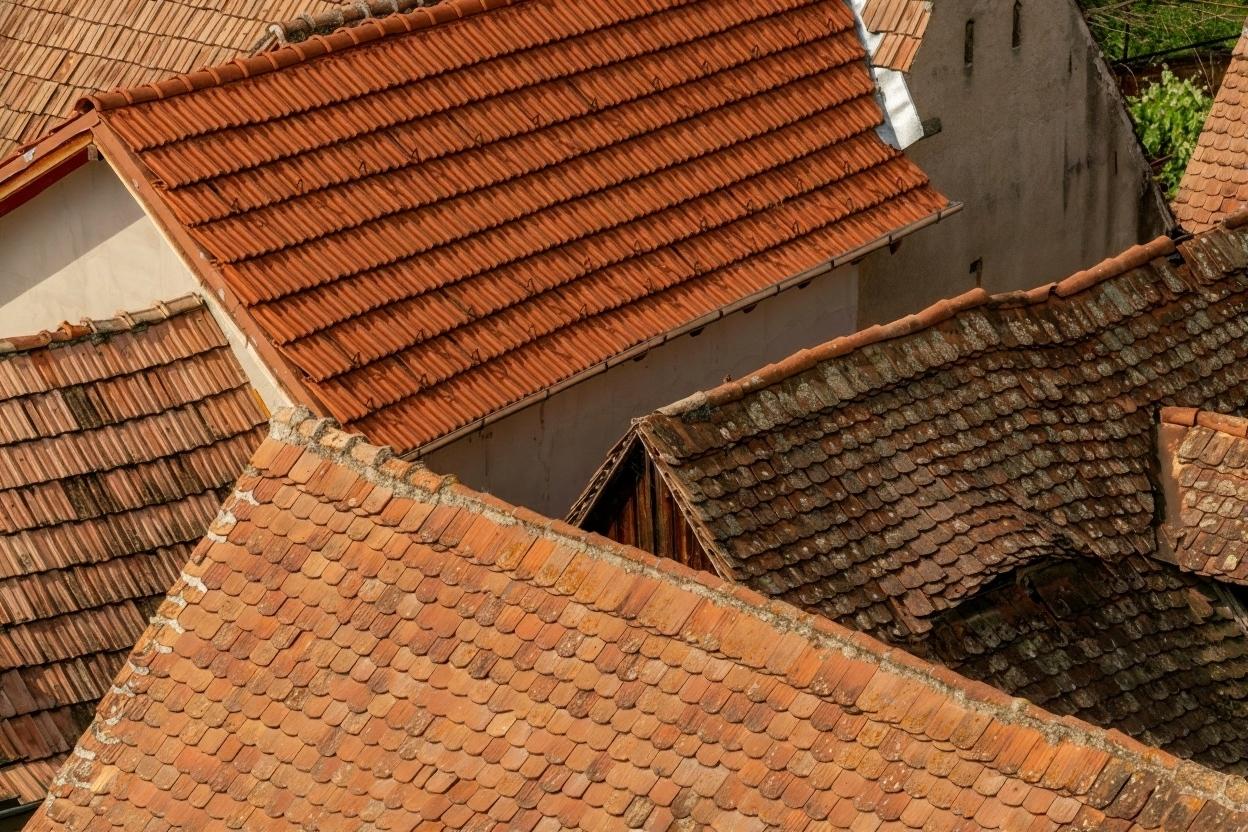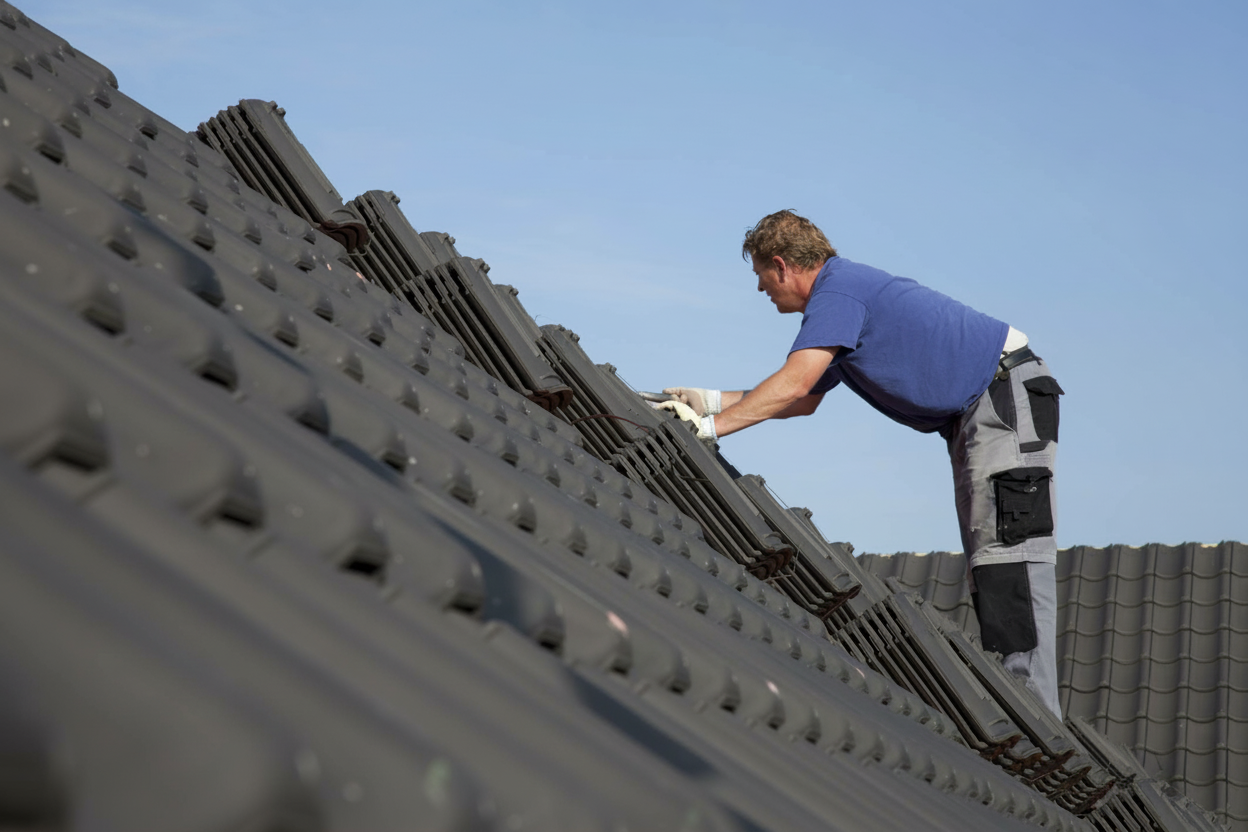
15 Warning Signs Your Tile Roof Needs Repair in 2025
Maintenance & Repair
Tile Roofing Installation
October 18,2025
15 Warning Signs Your Tile Roof Needs Repair in 2025

Alt text: Professional roofing contractor examining cracked and broken tiles on a residential roof to assess repair needs
Tile roofs offer exceptional durability and timeless beauty for your home. Whether you have clay, concrete, or slate tiles, these roofing systems can protect your property for 50 to 100 years with proper care. However, even the most resilient tile roofs show wear over time.
Catching roof damage early can save you thousands of dollars in repairs and prevent extensive water damage to your home’s interior.
Recognizing warning signs before they become major problems is essential for maintaining your roof’s integrity. This guide walks you through 15 clear indicators that your tile roof needs professional attention, helping you make informed decisions about repairs and maintenance.
Common signs of tile roof damage
Your tile roof communicates problems through visible and subtle indicators. Understanding these signs helps you address issues before they escalate into costly repairs or complete roof replacement.
1. Cracked or broken tiles
Cracks and breaks in roof tiles are among the most visible signs of damage. Severe weather, falling branches, or natural aging can cause tiles to fracture. When tiles crack, they expose the underlayment to moisture, UV rays, and temperature fluctuations.
Inspect your roof regularly from ground level using binoculars, or hire a professional for close examination. Even small cracks compromise your roof’s waterproofing and should be addressed promptly.
2. Water leaks and interior stains
Water stains on your ceiling or walls signal that moisture has penetrated your roof system. Leaks occur when tiles break, flashing deteriorates, or underlayment fails. Left unaddressed, water intrusion leads to mold growth, structural damage, and ruined insulation.
If you notice damp spots, peeling paint, or discoloration inside your home, investigate immediately. Water damage spreads quickly and becomes exponentially more expensive to repair over time.
3. Loose or missing tiles
High winds, improper installation, or aging adhesive can cause tiles to shift or fall off entirely. Missing tiles create vulnerable spots where water can enter your home. Loose tiles may slide further out of position during storms, causing cascading damage.
Walk your property after severe weather to check for tiles on the ground. If you spot gaps or misaligned tiles on your roof, schedule repairs before the next rainfall.
4. Moss and algae growth
While a little green growth might seem harmless, moss and algae indicate moisture retention problems. These organisms thrive in damp conditions and can accelerate tile deterioration by trapping water against the surface.
Regular roof cleaning and proper drainage prevent biological growth and extend your tile roof’s lifespan by years.
Consider professional cleaning if you notice significant moss coverage. Proper drainage and adequate sunlight exposure help prevent future growth.
5. Sagging roof sections
A sagging roofline indicates serious structural problems that require immediate attention. Sagging can result from water damage weakening support beams, excessive debris weight, or compromised roof decking.
Never ignore a sagging roof. This condition can lead to collapse and poses significant safety risks. Contact a roofing professional immediately for assessment and emergency repairs.

Alt text: Skilled technician replacing damaged roof tiles during repair work on a residential property
6. Granule loss on concrete tiles
Concrete tiles feature protective granules that shield against UV damage and weathering. Over time, these granules wear away, reducing the tile’s effectiveness and exposing the concrete underneath.
Check your gutters for granule accumulation. Significant granule loss means your tiles are nearing the end of their protective lifespan and may need replacement soon.
7. Damaged or deteriorated flashing
Flashing seals the joints where your roof meets chimneys, vents, skylights, and walls. Rust, cracks, or separation in flashing creates pathways for water infiltration.
Inspect flashing during roof maintenance. Replacing damaged flashing is relatively inexpensive compared to repairing water damage caused by failed seals.
8. Tile discoloration patterns
Uneven or sudden color changes in your roof tiles can indicate water damage, algae growth, or accelerated aging. While some fading is natural over decades, dramatic or patchy discoloration suggests underlying problems.
Document color changes with photos over time. Unusual patterns warrant professional inspection to identify the root cause.
9. Rising energy bills
An unexpected increase in heating or cooling costs may indicate your roof is no longer insulating effectively. Damaged tiles or compromised underlayment allow conditioned air to escape, forcing your HVAC system to work harder.
If your energy bills spike without explanation, have your roof inspected. Proper repairs can restore energy efficiency and reduce monthly costs.
10. Clogged or damaged gutters
Gutters direct water away from your roof and foundation. When gutters clog with debris or sustain damage, water backs up onto your roof, potentially seeping under tiles and causing leaks.
Clean your gutters seasonally and repair any damage promptly. Proper gutter function protects both your roof and your home’s foundation.
11. Aging roof system
Even well-maintained tile roofs eventually reach the end of their service life. Clay tiles typically last 50 to 100 years, while concrete tiles average 40 to 50 years. As your roof ages, it becomes more susceptible to damage and requires more frequent repairs.
If your roof is approaching its expected lifespan, schedule regular professional inspections. Proactive monitoring helps you plan for eventual replacement before emergency situations arise.
12. Debris accumulation
Leaves, branches, and dirt that collect on your roof trap moisture against the tiles, accelerating deterioration. Heavy debris also adds weight stress to your roof structure.
Remove debris regularly, especially after storms, to prevent moisture damage and extend your roof’s lifespan.
Remove debris regularly, especially after storms. Keep trees trimmed back from your roofline to minimize accumulation.
13. Unusual roof noises
Creaking, popping, or shifting sounds from your roof may indicate structural movement or loose tiles. Temperature changes cause expansion and contraction, but excessive noise suggests problems.
If you hear unusual sounds, particularly during weather changes, have a professional assess your roof’s structural integrity.
14. Poor original installation
Improper installation creates ongoing problems throughout your roof’s lifespan. Misaligned tiles, inadequate fastening, or incorrect underlayment lead to premature failure.
If you suspect installation issues, get a professional evaluation. Correcting installation problems early prevents compounding damage.
15. Visible interior water damage
Peeling paint, mold spots, or water stains inside your home definitively prove your roof is leaking. Interior damage means water has already penetrated multiple roof layers.
Address interior water damage immediately. The visible damage represents only a fraction of the total problem.
When to repair vs replace your tile roof
Deciding between repair and replacement depends on several factors. This comparison helps you make an informed choice:
| Factor | Repair | Replace |
|---|---|---|
| Damage extent | Under 30% of roof | Over 30% of roof |
| Roof age | Under 40 years | Over 50 years |
| Cost comparison | Less than 30% of replacement | Repairs exceed 50% of replacement |
| Future outlook | Isolated damage | Widespread deterioration |
Consult with roofing professionals to assess your specific situation. They can evaluate damage extent, roof age, and cost-effectiveness to recommend the best solution.
Protecting your tile roof investment
Your tile roof represents a significant investment in your home’s protection and curb appeal. Regular inspections and prompt repairs ensure you get the full lifespan from your roofing system.
Understanding the different types of tile roofs helps you maintain your specific material properly. Whether you have clay, concrete, or composite tiles, each material has unique characteristics and maintenance needs.
Proper tile roof installation from the start prevents many common problems. Quality installation ensures tiles are correctly aligned, adequately fastened, and properly sealed against the elements.
Regular tile roof cleaning removes debris and biological growth before they cause damage. Establishing a maintenance schedule keeps your roof in optimal condition year-round.
If you’re weighing options between materials, comparing clay vs concrete roof tiles helps you understand the durability and maintenance differences. Similarly, learning about terracotta tile roof characteristics can guide your repair or replacement decisions.
For homes with specific tile styles, understanding Spanish tile roof features or exploring barrel roof tiles options ensures repairs match your existing aesthetic.
When damage occurs, knowing how to repair cracked roof tile quickly prevents small problems from escalating. For more extensive issues, understanding tile roof leak repair techniques helps you work effectively with contractors.
Proper tile roof underlayment protects the layers beneath your tiles and extends your roof’s overall lifespan. Quality underlayment prevents water intrusion even when tiles sustain minor damage.
If you’re considering different roofing materials, reviewing tile vs shingle roofs in Florida helps you understand regional performance differences and make informed decisions.
Schedule professional roof inspections annually and after major storms. Experienced contractors identify problems you might miss and provide accurate repair estimates. Don’t wait for small issues to become emergencies.

